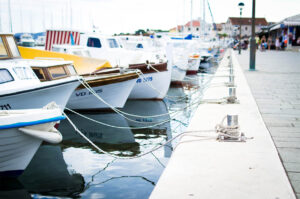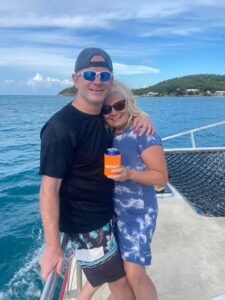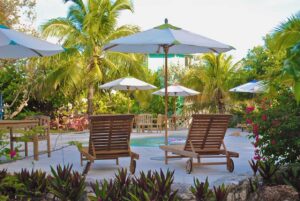Imagine being out on the water with family and friends and having a scary encounter with a large ship or tugboat. Not only can this ruin your day, it can severely compromise the confidence of your crew. As a ship pilot on the Chesapeake Bay for 41 years, I have had numerous close encounters with recreational boat traffic. Most of these situations were easily avoidable. Common sense, knowledge and experience are huge factors in keeping boaters safe. Don’t leave the dock without them. Here are recommendations for keeping it safe.
> Be vigilant.
It may sound silly, but not paying attention is often the culprit in these situations. Despite their size, commercial ships are generally quiet as they move through the water. Look aft regularly. A ship doing 15 knots, which isn’t uncommon, covers about 25 feet per second. That’s 1.5 nautical miles in six minutes!
> Know the rules of the road.
You can be sure the professional mariners do. However, true seamanship is demonstrated when a crew can recognize that holding fast to the right of way may not be the most prudent thing to do. Recreational boaters should understand that vessels limited in their ability to maneuver, whether because of draft or the confines of the channel, will have or need the right of way. It is also imperative to know that when a ship goes astern on its engine, directional control is limited at best. And traffic density plays a role. A small vessel forcing a commercial ship to change course could put others in jeopardy.
> Anticipate ship movements.
Generally, ships want to be in deep water. A look at your chart will give you a good idea of the route a ship might take to go from one point to another. Use navigational aids — are there mid-channel buoys or actual channels? When possible, remain clear of channels and the centers of bridge spans. If you don’t require the channels for safe navigation, why be there?
> Use your VHF radio.
In inland waters, the commercial traffic communicates on Channel 13. The hailing and distress frequency is Channel 16. Commercial vessels have at least two VHF radios on the bridge; one of them is on Channel 16. Be aware: on busy weekends, a call to a ship from a concerned boater on Channel 16 may not be heard over the other chatter. A conversation on Channel 13 might go like this: “Calling the northbound container ship off Bloody Point Light. This is the sailing vessel Temerity southbound east of Thomas Point Light.”
“This is the container ship Ever Resolute northbound at Bloody Point Light.” “Temerity back to Ever Resolute, we are a blue-hulled 42-foot sloop southbound approximately two miles off your port bow. How would you like to meet?” Note that the type of ship is stated, geographical position of both vessels given, and a brief description of the hailing vessel related. At sea, latitude and longitude might be used. A call is not always necessary, but if there is any question on your part, do not hesitate to make the call. The ships and tugboats are happy to speak with you. A tugboat with a barge in a tight turn demands the attention of any vessel meeting them. Perhaps a better course of action would be to meet on a prearranged straightaway by communicating on your VHF.
> Forward visibility can be problematic on some commercial vessels.
Aboard ships, small vessels may disappear from view a half mile or more away. A good rule of thumb for the recreational boater is to look for the ship’s navigation bridge. If you cannot see the windows, assume you are not seen.
> Risk of collision exists when two vessels are holding a constant bearing, or nearly so, with each other.
The give-way vessel should take early and substantial action to ensure that this is communicated clearly to the stand-on vessel in a timely fashion. Keep in mind that when it comes to commercial traffic, you might be meeting a vessel whose length exceeds 1,000 feet — greater than three football fields!
> AIS (Automatic Identification System) is an important aid to being seen electronically by commercial traffic.
Perhaps more importantly, it will give the recreational boater the actual name of the commercial vessel they would like to contact. Boaters should understand that although useful, AIS is primarily an identification system, not a collisionavoidance system. Also, AIS B (recreational) can be crowded out in a heavy AIS A (commercial) environment. AIS B signals are not updated as frequently as AIS A, resulting in possible erroneous information in close quarters situations.
> Understand whistle signals.
In inland waters, one whistle means “I am leaving you on my port side.” Two whistles means “I am leaving you on my starboard side.” Five or more short blasts is the danger whistle. This indicates that the whistle blower does not understand the intentions of the other vessel or that a safe passing is in doubt. It is unlikely that a large ship will hear the whistle signals of a recreational boat in time to avoid a close-quarters situation.
> Running in restricted visibility is challenging.
If the vessel operator does not have a clear understanding of the use of radar, poor visibility becomes positively dangerous. Radar reflectors are helpful but not a guarantee that you will be seen on a commercial vessel’s radar. If possible, move to shallower water using GPS and the depth finder to better stay out of harm’s way.





